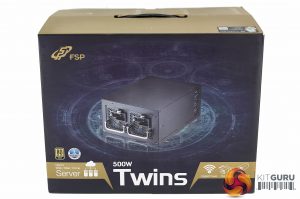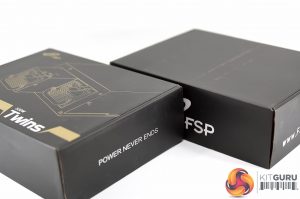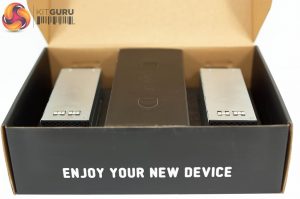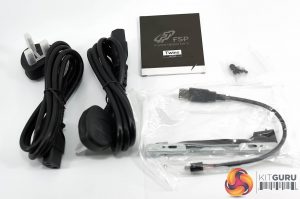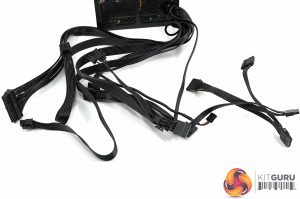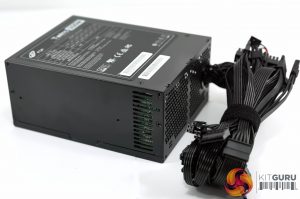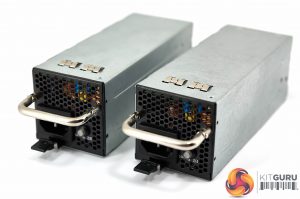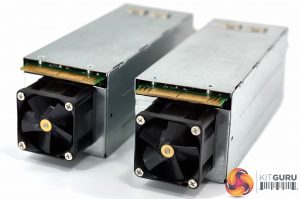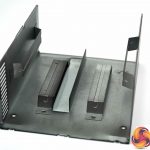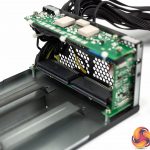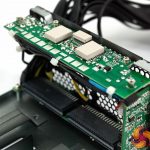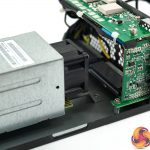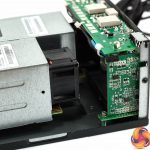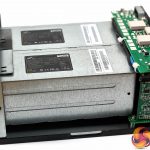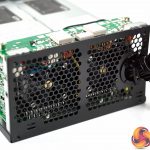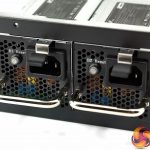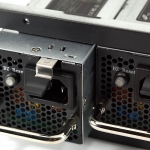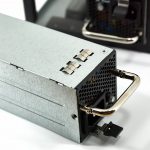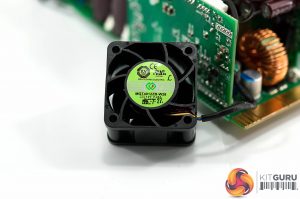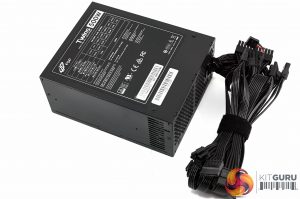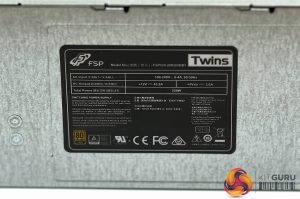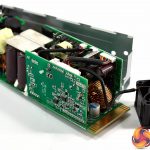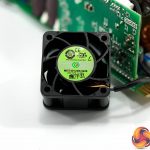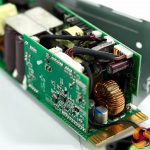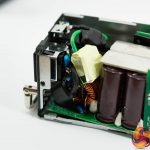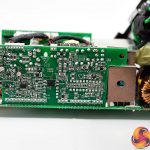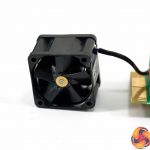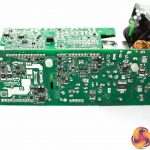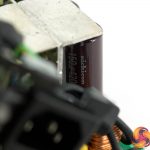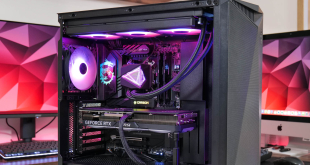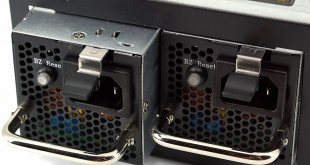
Today we take a look at the latest redundant power supply from OEM manufacturer FSP. This 500 watt unit is ideal for placement in servers or workstations within small business environments. The Twins 500W power supply actually incorporates two 520 watt supplies inside an outer ATX sized shell.
When the power supply is operating normally, each of the units shares the load, with the fall back option that if one fails then the other can take the full load – without any down time. The redundant. hot swappable concept is interesting and one we don't often get the chance to investigate.
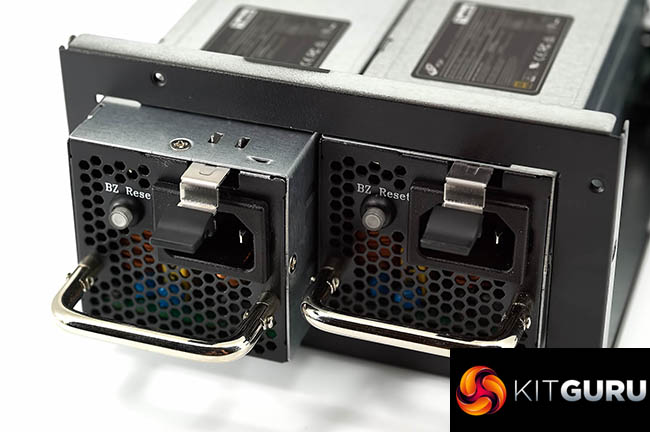
The FSP Twins 500W unit is a ‘server grade' supply and it has achieved 80 Plus Gold efficiency. A more powerful 700 watt model is due for release very soon. It does not have a front end bracket giving it compatibility with PS2 chassis.
FSP Twins overview:
- ATX PS2 redundant size, no front end bracket needed, ideal for mail, web and home server
- Digital-controlled power supply design can be monitored by “FSP Guardian ” software
- Hot swappable modules design and no worry about server/PC power off when one of modules failure
- Complete protection: over current protection, short circuit protection, over voltage protection, fan failure protection
- Alarm guard design by smart power supply status LED indicator
- 80 PLUS® 230V Internal Gold Certification
- Complies with ATX 12V and EPS 12V standards
- Flat ribbon cables, ideal solution for applications with space constraint issue
Review photography handled in house at KitGuru with a Leica S series medium format camera and S series prime lens.
The FSP Twins is shipped in a rather large box with a high resolution image of the supply itself clearly visible on the front.
Inside are two smaller boxes which contain the ATX chassis and other components and accessories.
One of the boxes contains the individual power supplies which fit inside the ATX chassis (in the other box). The little black box in the centre contains some accessories.
Inside the black box are two standard power connectors for each supply, a user manual and some fittings and cables for the build. The Twins power supply ships with a USB cable which can connect to the motherboard directly for monitoring support. You can download the monitoring and analysis software directly from the FSP website.
The main ATX unit has the following cables:
- 1x 24 pin ATX cable at 500mm
- 4+4 pin x 2 at 600mm
- 6+2 pin (2 connectors/1 cable) at 450mm + 150mm
- SATA/Molex cable at 450mm + 155mm(x4) (2 molex and 2 SATA headers).
- SATA cable at 550mm x 4 + 155mm
- Floppy connector at 100mm
- USB 8 Pin at 500mm
The ATX chassis is included in the second box and contains basically the ATX outer shell along with the hardwired cables which we discussed in more detail on the previous page.
Each of the power supplies is long and thin without any paintwork on the chassis. One side has a vent and a handle, as well as a locking pin row. The other side of each power supply has a fan attached to ensure there is enough air flow.
Below, a GALLERY showing an inside view of the ATX chassis and the two power supplies installed inside.
Each of the power supplies slides into the ATX housing and locks to the outer wall with a pin/lever system. Removing the power supplies is straightforward – push on the lever above the handle and pull out. Both are hot swappable, meaning if one fails, you can easily replace it without any downtime – this is incredibly important if you are running an important server or workstation and can't afford any downtime at all.
A red light is a sign of a problem, green indicates normal operation. The user manual explains all the status modes in detail.
Each of the power supplies is fitted with a 40mm fan mounted on the front – this is a Protechnic Electric MGT4012ZB-W28 which is rated 0.49A at 12 VDC. It is a double bearing fan, especially important considering how fast these little fans may have to spin when each unit is under load.
I have always been outspoken against using small fans due to the noise they can emit, but in this kind of space restricted environment there is little choice.
![]()

Each FSP power supply can handle 520 watts at a 50c rating and they adopt a single +12v rail at 43.3A which translates into 519.6W). The modular supplies incorporate a +5VSB output as well.
When both supplies are hooked into the main ATX sized chassis, the overall power rating is 500 watts. The architecture inside the main chassis frame combine the output of both units while generating the +3.3V, +5V and +12V outputs.
Below, a GALLERY showing an inside view of one of the power supplies which slide inside the main ATX chassis.
Internally, the OEM design is obviously by FSP. The two modular units plug into the main ATX chassis shown earlier on this page. There are multiple boards in the front that will handle the power distribution between the units. Remember when both power supplies are working fine, they share the load. The +3.3V, +5V and +12V outputs are generated on the main PCB inside the chassis. FSP adopt current limiters to switch the +12V output from the modular supplies into three 16A +12V outputs.
The overall build and construction is really exceptionally good and soldering seems very high grade throughout.
Correctly testing power supplies is a complex procedure and KitGuru have configured a test bench which can deliver up to a 2,000 watt DC load. We run ambient temperatures of 35c in this environment to greater reflect warmer internal chassis conditions.
We use combinations of the following hardware:
• SunMoon SM-268
• CSI3710A Programmable DC load (+3.3V and +5V outputs)
• CSI3711A Programmable DC load (+12V1, +12V2, +12V3, and +12V4)
• Extech Power Analyzer
• Extech MultiMaster MM570 digital multimeter
• SkyTronic DSL 2 Digital Sound Level Meter (6-130dBa)
• Digital oscilloscope (20M S/s with 12 Bit ADC)
• Variable Autotransformer, 1.4 KVA
|
DC Output Load Regulation
|
||||||||||
|
Combined DC Load |
+3.3V
|
+5V
|
+12V
|
+5VSB
|
-12V | |||||
|
A
|
V
|
A
|
V
|
A
|
V
|
A
|
V
|
A | V | |
|
50W
|
0.92
|
3.30
|
0.85
|
5.01
|
3.13
|
12.00
|
0.50
|
5.07
|
0.20
|
-12.01
|
|
100W
|
1.60
|
3.29
|
1.65
|
5.01
|
6.70
|
11.98
|
1.00
|
5.05
|
0.20
|
-12.01
|
|
250W
|
2.95
|
3.27
|
2.90
|
5.00
|
18.00
|
11.96 |
1.50
|
5.04
|
0.20
|
-12.02
|
| 375W |
4.05
|
3.27
|
4.10
|
4.98
|
28.00
|
11.90
|
2.00
|
5.00 |
0.30
|
-12.03
|
|
500W
|
5.00
|
3.27
|
5.35
|
4.96
|
37.32
|
11.87
|
2.50
|
4.97
|
0.30
|
-12.03
|
Load regulation is pretty good across the range of figures however compared to some of the latest desktop power supplies we have reviewed, they are a little disappointing. That said, this is a very different style of power supply comprising parallel units running in tandem, so this is to be expected to a certain extent. Results do remain within industry rated tolerance guidelines.
To simulate a unit failure, we unplugged one of the power supply bays power connectors. The single unit handled the task well with only minor fluctuations. The fall back redundancy feature certainly seems to work well.
| FSP Twins 500W Redundant Power Supply | Maximum Load |
| 545 watts |
We managed to get the PSU to deliver 545 watts before it would shut down, delivering around 45 watts more than the rated specifications.
Next we want to try Cross Loading. This basically means loads which are not balanced. If a PC for instance needs 500W on the +12V outputs but something like 30W via the combined 3.3V and +5V outputs then the voltage regulation can fluctuate badly.
| Cross Load Testing | +3.3V | +5V | +12V | -12V | +5VSB | |||||
| A | V | A | V | A | V | A | V | A | V | |
| 390W | 2.0 | 3.29 | 2.0 | 5.03 | 30.0 | 11.88 | 0.2 | -12.00 | 0.50 | 5.00 |
| 170W | 18.0 | 3.24 | 12.0 | 4.92 | 4.0 | 11.99 | 0.2 | -12.01 | 0.50 | 5.03 |
The unit passed our cross load test without any major issues.
We then used an oscilloscope to measure AC ripple and noise present on the DC outputs. We set the oscilloscope time base to check for AC ripple at both high and low ends of the spectrum. ATX12V V2.2 specification for DC output ripple and noise is defined in the ATX 12V power supply design guide.
|
ATX12V Ver 2.2 Noise/Ripple Tolerance
|
|
|
Output
|
Ripple (mV p-p)
|
|
+3.3V
|
50
|
|
+5V
|
50
|
|
+12V1
|
120
|
|
+12V2
|
120
|
|
-12V
|
120
|
|
+5VSB
|
50
|
Obviously when measuring AC noise and ripple on the DC outputs the cleaner (less recorded) means we have a better end result. We measured this AC signal amplitude to see how closely the unit complied with the ATX standard.
| AC Ripple (mV p-p) | ||||
| DC Load | +3.3V | +5V | +12V | 5VSB |
| 50W | 10 | 10 | 40 | 5 |
| 100W | 15 | 10 | 45 | 5 |
| 250W | 15 | 15 | 45 | 10 |
| 375W | 15 | 15 | 50 | 10 |
| 500W | 20 | 15 | 55 | 10 |
Ripple suppression falls within industry rated parameters with the +3.3V and +5 output peaking at 20mV and 15mV respectively. The 12V output peaks at 55mV under full load – well within industry rated parameters, although higher than what we would consider an average of our review samples taken in the last year.
|
Efficiency (%)
|
|
|
50W
|
71.23
|
|
100W
|
81.44
|
|
250W
|
91.23
|
|
375W
|
90.32
|
|
500W
|
89.45
|
Efficiency is actually very good, hitting a peak around 91.2% – and dropping to close to 89.5% at 100% load.
We take the issue of noise very seriously at KitGuru and this is why we have built a special home brew system as a reference point when we test noise levels of various components. Why do this? Well this means we can eliminate secondary noise pollution in the test room and concentrate on components we are testing. It also brings us slightly closer to industry standards, such as DIN 45635.
Today to test the Power Supply we have taken it into our acoustics room environment and have set our SkyTronic DSL 2 Digital Sound Level Meter (6-130dBa) one meter away from the unit. We have no other fans running so we can effectively measure just the noise from the unit itself.
As this can be a little confusing for people, here are various dBa ratings in with real world situations to help describe the various levels.
KitGuru noise guide
10dBA – Normal Breathing/Rustling Leaves
20-25dBA – Whisper
30dBA – High Quality Computer fan
40dBA – A Bubbling Brook, or a Refrigerator
50dBA – Normal Conversation
60dBA – Laughter
70dBA – Vacuum Cleaner or Hairdryer
80dBA – City Traffic or a Garbage Disposal
90dBA – Motorcycle or Lawnmower
100dBA – MP3 Player at maximum output
110dBA – Orchestra
120dBA – Front row rock concert/Jet Engine
130dBA – Threshold of Pain
140dBA – Military Jet takeoff/Gunshot (close range)
160dBA – Instant Perforation of eardrum
|
Noise (dBA)
|
|
|
50W
|
33.7
|
|
100W
|
34.4
|
|
250W
|
38.8
|
|
375W
|
40.6
|
| 500W | 51.1 |
Unfortunately, running two 40mm fans at high speed is going to get noisy. The fans sound like mini helicopters at close to full load and they will drown out any case or cooler fans in most systems if you are driving close to 400 watts or higher.
I found this power supply difficult to deal with with a demand over 350 watts if I was being honest – the two 40mm fans spin up to compensate for rising heat levels inside, and they become intrusive and very annoying. Nothing FSP can do about this really, they are forced to use super small fans to accommodate the diminutive dual bay structure of this unit.
|
Temperature (c)
|
||
|
Intake
|
Exhaust
|
|
|
50W
|
36
|
39
|
|
100W
|
39
|
45
|
|
250W
|
42
|
51
|
|
375W
|
43
|
56
|
|
500W
|
46
|
61
|
The tiny fans have to work hard to maintain the FSP thermal profile, but they actually handle it all very well. If you can deal with the noise that is.
|
Maximum load
|
Efficiency
|
|
545W
|
88.8
|
For those interested, we measured efficiency when stressing the unit to breaking point. 88.8 percent efficiency at 545W … hardly practical, but interesting regardless.
It has been some time since I have analysed a Redundant power supply and it proved an interesting review from my own perspective. There is no doubt that FSP have produced a quality 500 watt unit – the Twins can handle in excess of 500 watts load demand for extended periods of time. The build quality and design implementation is excellent.
If you are looking at this power supply for a new gaming system build, then I would recommend you look elsewhere. After 400 watts or greater load, the dual 40mm fans spin excessively fast to produce enough airflow. The downside is a cacophony of noise which would be difficult to live with.
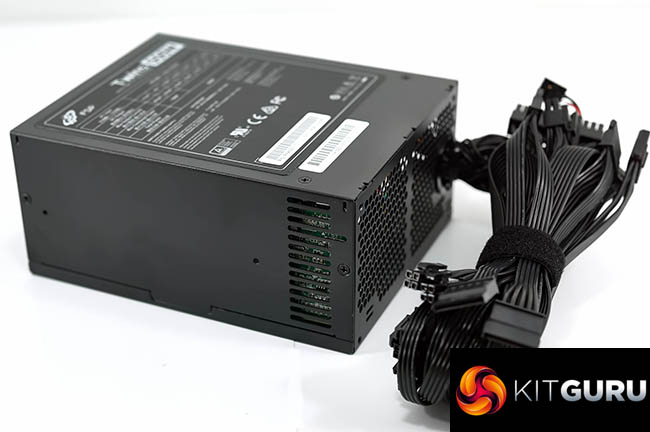
Realistically, the Twins power supply is designed for a home or small business server, or even an ‘always on' home workstation system. The dual power supply failsafe feature works very well and any potential downtime would be kept to an absolute minimum.
It is unusual to see two 520 Watt units inside a single ATX chassis and under normal operation the Twins works as a single 500 watt unit, with both supplies sharing the load. If one of the supplies fails, then the remaining unit will keep the system running while you hot swap it for another fully working supply module. The fail safe mode seems bulletproof – we tried a variety of checks with this. We pulled the plug on one when idle and under load, and the remaining unit flawlessly took over, without any downtime at all.
Technically the unit is solid, if unremarkable. Efficiency, load regulation and cross loading performs at a similar level to a traditionally designed high quality entry level desktop power supply. I honestly would not use it at home, but I am rather susceptible to fan noise and I found using the FSP Twins under any modest load situation could quickly become unbearable. If you have a 24/7 server in the garage however or perhaps in a closet or in the attic, then the noise wouldn't be such of a concern at home.
FSP supply a 5 year warranty with their latest Twins power supply. Right now we have no UK pricing for the Twins, but it is available from Amazon and Newegg in America for $399.99. We are waiting to get confirmed UK pricing. This is a specialist unit targeting a niche demographic – and for those people we can certainly say it is worth buying. If you are a desktop enthusiast gamer then I would suggest you get a high grade standard desktop power supply and invest some money into a high grade UPS system.
Pricing is set at $399.99 in America with UK retailers waiting on stock.
Discuss on our Facebook page, over HERE.
Pros:
- Exceptional build quality.
- Software package is useful.
- High quality design.
- Stable power delivery.
- Redundancy works flawlessly.
- 5 year warranty.
Cons:
- Very high noise levels.
- $399 – if we get a dollar to pound conversion? very expensive.
Kitguru says: If you are in the market for a high grade power supply for a home or small business server and need redundancy then the FSP Twins comes highly recommended.
 KitGuru KitGuru.net – Tech News | Hardware News | Hardware Reviews | IOS | Mobile | Gaming | Graphics Cards
KitGuru KitGuru.net – Tech News | Hardware News | Hardware Reviews | IOS | Mobile | Gaming | Graphics Cards


